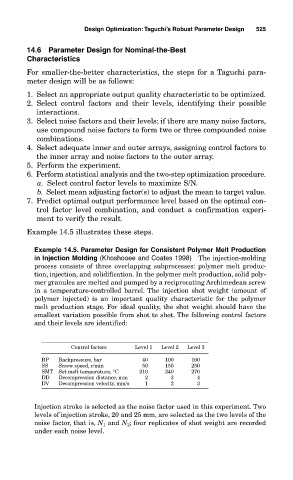Page 567 - Design for Six Sigma a Roadmap for Product Development
P. 567
Design Optimization:Taguchi’s Robust Parameter Design 525
14.6 Parameter Design for Nominal-the-Best
Characteristics
For smaller-the-better characteristics, the steps for a Taguchi para-
meter design will be as follows:
1. Select an appropriate output quality characteristic to be optimized.
2. Select control factors and their levels, identifying their possible
interactions.
3. Select noise factors and their levels; if there are many noise factors,
use compound noise factors to form two or three compounded noise
combinations.
4. Select adequate inner and outer arrays, assigning control factors to
the inner array and noise factors to the outer array.
5. Perform the experiment.
6. Perform statistical analysis and the two-step optimization procedure.
a. Select control factor levels to maximize S/N.
b. Select mean adjusting factor(s) to adjust the mean to target value.
7. Predict optimal output performance level based on the optimal con-
trol factor level combination, and conduct a confirmation experi-
ment to verify the result.
Example 14.5 illustrates these steps.
Example 14.5. Parameter Design for Consistent Polymer Melt Production
in Injection Molding (Khoshooee and Coates 1998) The injection-molding
process consists of three overlapping subprocesses: polymer melt produc-
tion, injection, and solidification. In the polymer melt production, solid poly-
mer granules are melted and pumped by a reciprocating Archimedean screw
in a temperature-controlled barrel. The injection shot weight (amount of
polymer injected) is an important quality characteristic for the polymer
melt production stage. For ideal quality, the shot weight should have the
smallest variation possible from shot to shot. The following control factors
and their levels are identified:
Control factors Level 1 Level 2 Level 3
BP Backpressure, bar 40 100 160
SS Screw speed, r/min 50 150 250
SMT Set melt temperature, °C 210 240 270
DD Decompression distance, mm 2 3 4
DV Decompression velocity, mm/s 1 2 3
Injection stroke is selected as the noise factor used in this experiment. Two
levels of injection stroke, 20 and 25 mm, are selected as the two levels of the
noise factor, that is, N 1 and N 2 ; four replicates of shot weight are recorded
under each noise level.

